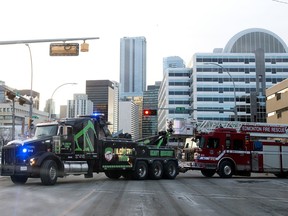“The current replacement budget is in the process of being adjusted as, while it did account for inflation, no one expected to see such dramatic price increases for new orders”

Article content
Spiralling costs for fire trucks and other apparatus — and a lack of inventory — are keeping Alberta municipalities from keeping up with replacing millions in aging equipment.
Edmonton Fire Rescue Services (EFRS) has a $1.9 million negative budget variance due to higher than expected repair costs due to an aging fleet, increased pumper and ladder maintenance, and parts price inflation.
Advertisement 2
Article content
Article content
And the EFRS fleet is facing cost increases for replacing aging apparatus, said Fire Chief Joe Zatylny.
“Our costs have significantly gone up over the last couple of years,” he said in a livestreamed conversation on Facebook with Ward Karhiio Coun. Keren Tang on Monday.
Everything’s going up, including the cost of fuel and maintenance for wear and tear as a result of increased calls and a larger population.
“We’re doing a deep dive in right now to see what we can do to manage that. The costs are going up across the board,” he said.
Asked by Postmedia about specifics, the EFRS public information office released a statement.
“Currently, apparatus lifecycles are being discussed as the price of replacements has increased dramatically over the last five years. If the units go beyond their expected lifecycles, it is highly likely repair costs will increase. The current replacement budget is in the process of being adjusted as, while it did account for inflation, no one expected to see such dramatic price increases for new orders,” the statement said.
“Edmonton fire’s apparatus lifecycle can be adjusted in consultation with the City of Edmonton’s fleet services branch. This is dependent on analytic trends seen, as well as a cost analysis of repair and replacement costs,” the statement said.
Article content
Advertisement 3
Article content

Currently, pumps are allotted 14 years while tankers, aerials and rescues have a life span of 18 years, a schedule adopted in 2018, the statement said.
Postmedia learned the EFRS has an inventory of 46 pumps, with 32 in service; 15 ladders, with nine of them in service, 12 rescues, with eight of them in service; and nine tankers, with six of them in service.
“We’ll continue to replace our pumps every 14 years, and our rescues, ladders and our smaller tenders. Plus we don’t want to go too far because there does become a point where your units do cost more to keep them in service than when you’re in a better position to replace them rather than extending the life of them,” Zatylny said Monday.
‘Never in our wildest dreams’
Red Deer Fire Chief Ken McMullen is president of the Canadian Association of Fire Chiefs, which showed in its 2022 and 2023 census that 50 per cent of all fire departments deferred training and equipment purchases for financial reasons.
Municipalities have always known they replace big ticket items on a life-cycle basis, factoring in inflation over the decade or two involved, he said.
Advertisement 4
Article content
“But we’ve never in our wildest dreams planned for a 30 to 40 per cent inflation and we just simply don’t have that in our budgets,” McMullen said.
Then there’s the other horn of the dilemma — waiting time.
If you’re lucky enough to have the funds available, you have to wait anywhere from one year to three years for new equipment, he said.
Recommended from Editorial
Infrastructure spending shrinks
Municipalities get money to fund infrastructure from the federal government’s Canada Community Building Fund and from the provincial government through the Local Government Fiscal Framework, supplemented by borrowing and cash reserves.
Tang said provincial funding for infrastructure, including municipal fleets, has decreased to $154 per person in 2024 from $424 per Albertan in 2011, according to Alberta Municipalities.
“There’s a huge gap,” Tang said. “So here we are. We have a government that’s telling people to move here, they’re giving folks a moving bonus for certain trade workers, yet they’re not funding communities to develop the infrastructure to keep these people in place,” she said.
Advertisement 5
Article content
Edmontonians are already smarting from reported estimates of an eight per cent tax hike.
“Property tax is not a sustainable source of revenue to meet the demands of growth. You can’t do that,” she said.
It’s something of a perfect storm for municipalities, Tang said.
“We’re hitting our internally imposed debt ceiling for what we can borrow as well.”
Feeling it at manufacturing level
Mike Feduniw is sales manager for Commercial Emergency Equipment, which has fire vehicle contracts with the City of Calgary, among other municipalities.
“We are getting lots of feedback from municipal customers. They’re seeing budgetary pressures across the board,” Feduniw said.
“Prices really started to increase at the end of 2020. And we saw a very sharp increase on the fire apparatus side of things. We’re seeing more stability now than what there has been. It still doesn’t change the fact that five-year capital planning is creating some issues on the municipal front,” Feduniw said.
“The bigger pressure that we see is order intake for fire apparatus across the last four years is significantly higher than what it was. Their lead times are starting to extend due to components shortages.”
Article content





